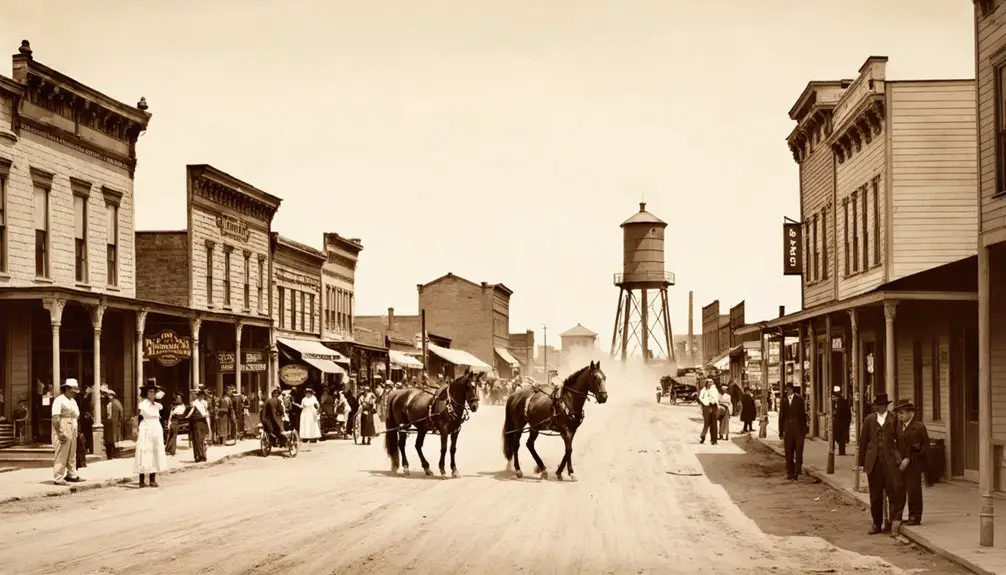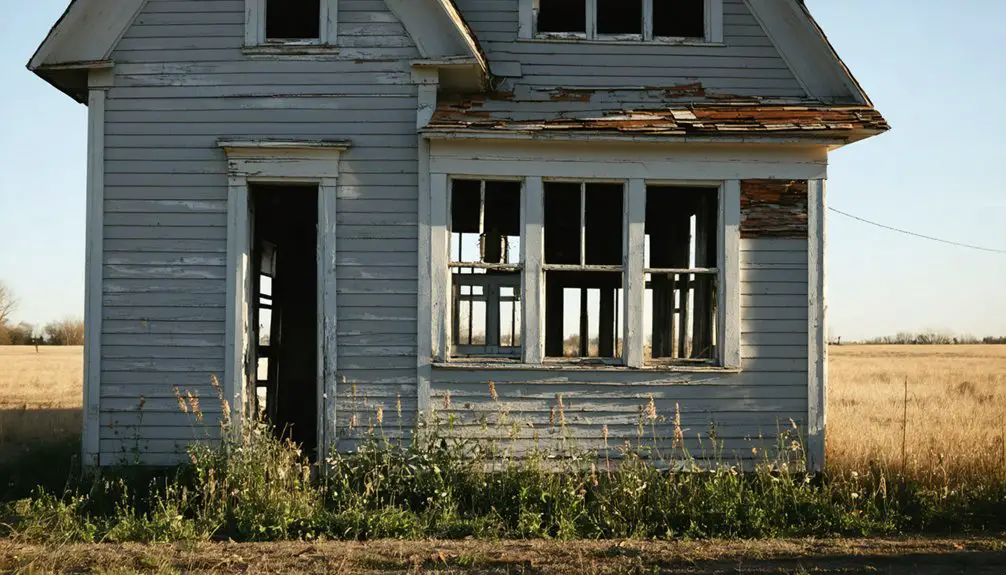You’ll find Reeding in Oklahoma’s ghost town history, founded in 1887 by Joseph S. “Buckskin Joe” Works. This frontier settlement began as a trading post serving Native Americans and cattle drivers, growing to include a Protestant church, school, and bustling general store. While resource extraction drove its early success, transportation shifts and economic challenges eventually led to its decline. Today, concrete foundations, flooded mine shafts, and scattered remnants tell a deeper story of frontier boom-and-bust cycles.
Key Takeaways
- Reeding began as a trading post in 1887, founded by “Buckskin Joe” Works, with a post office named Navajoe serving the community.
- The town’s economy relied heavily on resource extraction and railroad connections, leading to eventual boom-and-bust cycles.
- Community life centered around the general store, Baptist church, and Navajoe School during the town’s prime years.
- Transportation shifts and resource depletion led to Reeding’s decline, with younger residents moving to larger cities for opportunities.
- Today, remnants include concrete foundations, abandoned homes, and fifteen flooded coal shafts amid overgrown fields and forests.
The Birth and Early Days of Reeding
While Texas land promoter Joseph S. “Buckskin Joe” Works often receives credit for founding Reeding in 1887, the town’s roots actually began a year earlier when brothers-in-law W.H. Acers and H.P. Dale established a general store to trade with Native Americans and cattle drivers.
Brothers-in-law Acers and Dale paved the way for Reeding’s founding by opening a trading post before Buckskin Joe arrived.
You’ll find that settler motivations centered on creating a permanent community, evidenced by their successful application for a post office named “Navajoe” on September 1, 1887.
When Buckskin Joe arrived on July 4, 1887, he laid out an 80-acre town site, receiving half the lots for his promotional work.
Like many other frontier boomtowns in Oklahoma, the settlement experienced rapid growth due to its strategic location and available resources.
The community dynamics quickly evolved beyond a simple trading post, with the establishment of the region’s first Protestant church and a school, signaling the town’s transformation from frontier outpost to an organized settlement within Greer County, Texas.
Their store flourished despite the ongoing boundary dispute between Texas and the U.S. government over the rightful jurisdiction of Greer County.
Economic Forces That Shaped the Town
Like many Oklahoma settlements of its era, Reeding’s economic story centered on resource extraction, making it vulnerable to the boom-and-bust cycles that defined frontier development.
You’ll find its growth was meteoric during resource-rich periods, with workers flooding in for high-wage opportunities despite harsh conditions. Workers faced significant health risks as tuberculosis and diphtheria spread rapidly through the overcrowded camps. The mine disaster of Cloud Chief in 1906 led to stricter safety regulations across Oklahoma mining towns.
The town’s fate was inextricably linked to transportation networks, particularly the railroad system that carried its resources to market.
When rail connections thrived, so did Reeding’s economy. But this dependency proved precarious – any disruption to rail service or resource extraction, whether from industrial accidents, natural disasters, or market forces, sent shockwaves through the community.
As the local industry matured and mechanized, the town’s workforce needs shifted, ultimately contributing to its decline and eventual ghost town status.
Life in Reeding’s Prime Years

Three pivotal institutions shaped daily life in Reeding during its prime years from 1887 to 1888: the general store, Baptist church, and Navajoe School.
You’d find the community dynamics centered around W.H. Acers and H.P. Dale’s general store, where settlers and Native Americans engaged in daily trade. Cultural interactions flourished as families gathered for Sunday services at the first Protestant church in what would become Oklahoma Indian Territory. Much like the oil boom wealth that would later define Skiti, Reeding experienced its own brief period of prosperity.
The newly opened Navajoe School brought children together, fostering literacy and education among the town’s youth. Like many Oklahoma settlements affected by railroad routing decisions, Reeding’s prosperity hinged on transportation access.
Life revolved around these community hubs, with families settling into plotted lots promoted by “Buckskin Joe” Works. The post office, named “Navajoe” with its distinctive spelling, served as a crucial communication link, while social activities typically centered on church gatherings and school events.
The Slow Fade Into Ghost Town Status
After its brief period of prosperity in the late 1880s, Reeding’s transformation into a ghost town unfolded through a complex web of economic and social factors.
You’d have seen the town’s decline accelerate as transportation shifts bypassed the settlement, cutting off essential commercial routes that once brought travelers and trade through its streets.
Much like the infamous No Man’s Land region, the area struggled with maintaining a stable population and economy.
The town’s fate mirrored many Oklahoma communities facing similar challenges.
Like countless rural settlements, Reeding couldn’t sustain itself once its initial resources were depleted.
Similar to Carter 9’s fate after the oil boom decline, Reeding’s economic foundation crumbled.
Demographic changes hit hard as younger residents moved to larger cities seeking better opportunities.
Young hearts abandoned small-town dreams, drawn to city lights and promises of bigger futures beyond Reeding’s fading horizons.
Natural disasters, possibly including drought periods and dust storms, further stressed the remaining population.
Without sustainable industries to replace its original economic base, Reeding’s businesses closed one by one, and its population dwindled until only empty buildings remained.
What Remains Today: A Historical Legacy
Time-worn remnants of Reeding’s mining heyday dot the Oklahoma landscape, telling stories of its industrial past.
You’ll find concrete abutments and foundations from the original mine facilities, while scattered homes – most abandoned but a few still occupied – stand as historical remnants of the once-thriving community.
The business district has surrendered to nature’s reclamation, with fields and forest now dominating the scene. Due to extensive environmental damage, barbed wire fencing now restricts access to hazardous areas.
The most significant mining artifacts are the fifteen flooded coal shafts and the memorial commemorating the devastating mine collapse.
You can trace former rail lines and observe the 8-10 foot ground subsidence that reshaped the terrain.
While there’s no formal tourism infrastructure, you’re free to explore these ghostly remains, though you’ll need to navigate carefully through overgrown areas and deteriorating structures.
Frequently Asked Questions
Were Any Notable Outlaws or Lawmen Associated With Reeding During Its Existence?
You won’t find any documented outlaw legends or lawman stories tied to Reeding. Historical records show no notorious criminals or famous law enforcement figures operating in this small settlement.
What Native American Tribes Originally Inhabited the Land Where Reeding Was Established?
Before you’d find settlers there, you’d discover rich tribal history of the Comanche, Kiowa, and Wichita peoples, who’d established their cultural heritage across these grasslands through seasonal hunting and migration patterns.
Did Reeding Have Any Unique Local Customs or Annual Celebrations?
You won’t find records of unique local traditions or annual fairs specific to Reeding. Like other small Oklahoma towns, they likely shared common regional celebrations through their church, school, and community gatherings.
Were There Any Documented Paranormal Activities in Reeding’s Abandoned Buildings?
You won’t find documented ghost sightings in Reeding’s abandoned structures, despite Oklahoma’s rich paranormal history. Like many small ghost towns, any local stories haven’t been officially recorded or investigated.
What Happened to the Cemetery and Burial Records From Reeding?
You’ll find that Reeding’s cemetery preservation efforts failed as the town emptied. Most burial records were lost, scattered, or merged into broader Kingfisher County archives, while the physical cemetery likely remains unmarked and undocumented.
References
- https://digging-history.com/2014/09/24/ghost-town-wednesday-navajoe-oklahoma/
- https://en.wikipedia.org/wiki/List_of_ghost_towns_in_Oklahoma
- https://www.okhistory.org/publications/enc/entry?entry=GH002
- https://www.youtube.com/watch?v=fbkGykYf0hg
- https://okmag.com/blog/a-ghostly-site/
- https://echo.snu.edu/the-ghost-towns-of-oklahoma/
- https://jrap.scholasticahq.com/api/v1/articles/9543-the-economics-of-ghost-towns.pdf
- https://nondoc.com/2022/01/04/whizbang-oklahoma-ghost-town/
- https://www.youtube.com/watch?v=5d-wHDTIbb0
- https://www.youtube.com/watch?v=aeAXyEw70io



